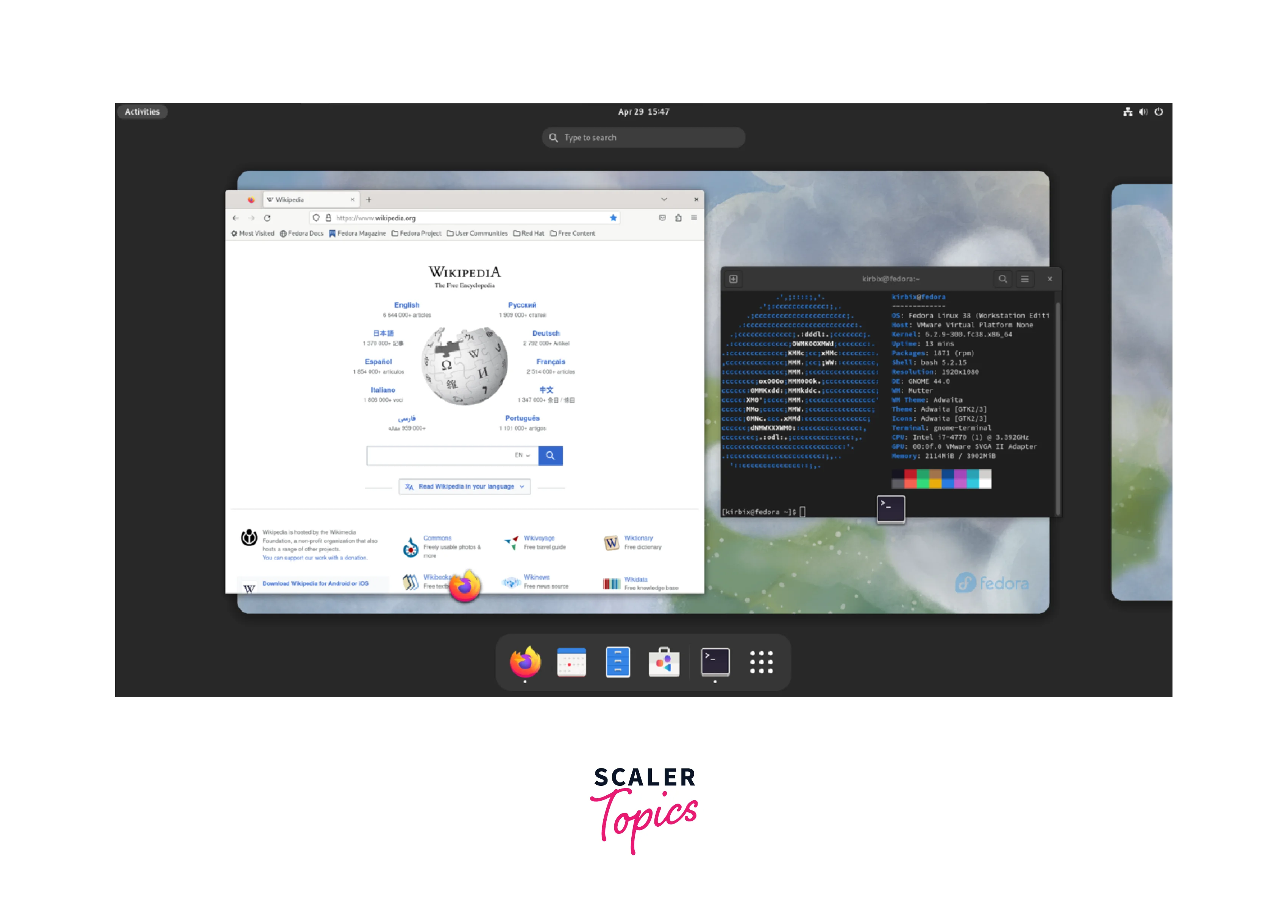Why Fedora Linux Is Growing Popular Over the Years
Overview
In the vast of Linux operating systems, Fedora has emerged as a prominent player, gaining popularity and a dedicated user base over the years. With its strong emphasis on software freedom, bleeding-edge updates, and a vibrant community, Fedora has become a go-to choice for tech enthusiasts and professionals alike. This blog post will delve into the reasons behind the ever-growing popularity of Fedora Linux, exploring its history, unique features, applications, and advantages.
What is Fedora?
Fedora is a Linux-based operating system that aims to provide the latest free and open-source software while embracing a community-driven approach. It is known for its cutting-edge technology and commitment to promoting software freedom. Fedora is maintained by the Fedora Project, a community-led initiative supported by Red Hat, a prominent name in the world of enterprise-level open-source solutions.

Versions of Fedora Linux
Fedora Workstation: Designed for desktop users, developers, and content creators, providing a user-friendly environment and a comprehensive set of tools.
Fedora Server: Optimized for server deployments, offering stability and performance for running web servers, databases, and other server applications.
Fedora CoreOS: Geared towards running containerized workloads with automatic updates and minimal maintenance.
Fedora Silverblue: An immutable desktop OS using the RPM-OSTree system for enhanced stability, security, and easy rollbacks.
Fedora IoT: Meant for Internet of Things (IoT) devices and applications, supporting various hardware architectures.
Fedora Spins: Alternative versions of Fedora featuring different desktop environments. Some popular spins include:
- Fedora KDE Plasma Spin: Featuring the KDE Plasma desktop environment for a customizable user experience.
- Fedora Xfce Spin: A lightweight version with the Xfce desktop environment for low-resource systems.
- Fedora LXQt Spin: Utilizing the LXQt desktop environment, suitable for older or resource-constrained hardware.
- Fedora MATE Spin: Offering the MATE desktop environment for a traditional and straightforward interface.
- Fedora Cinnamon Spin: Featuring the Cinnamon desktop environment, providing an intuitive and modern UI.

History of Fedora Operating System
Fedora originated in 2003 as the Fedora Project under the sponsorship of Red Hat. It was created as a community-supported, free distribution of Red Hat Linux after Red Hat decided to shift its focus exclusively to the enterprise market with Red Hat Enterprise Linux (RHEL). The project aimed to provide a platform for rapid innovation and serve as a testing ground for technologies that could eventually find their way into Red Hat's commercial offering. Since its inception, Fedora has seen steady growth and has become a widely recognized and respected Linux distribution.
Applications of the Fedora Operating System
Web Browsers: Mozilla Firefox, Google Chrome, Chromium, Brave.
Office Productivity: LibreOffice (Writer, Calc, Impress), GNOME Office (AbiWord, Gnumeric).
Email Clients: Thunderbird, Evolution, Geary, Claws Mail.
Multimedia Players: VLC media player, GNOME Videos (Totem), Rhythmbox, Audacious.
Graphics and Image Editing: GIMP (GNU Image Manipulation Program), Inkscape, Krita, Shotwell.
Video Editing: Kdenlive, OpenShot, Pitivi.
Audio Editing: Audacity, Ardour.
Virtualization: VirtualBox, GNOME Boxes, QEMU/KVM.
Containerization: Docker, Podman, Buildah.
Development Tools: GCC, GDB, Python, Ruby, Node.js, Java, Visual Studio Code, Sublime Text.
Database Management: MySQL, PostgreSQL, SQLite.
Networking Tools: Wireshark, Nmap, net-tools, NetworkManager.
Security Tools: SELinux, ClamAV, AIDE, rkhunter.
Gaming: Steam, Wine, Lutris, RetroArch.
Utilities: GParted (partition editor), Timeshift (system backup tool), GNOME Disk Utility.
Advantages and Unique Features of the Fedora Operating System
Here are some of its key advantages and distinctive characteristics:
Security-Enhanced Linux (SELinux): Fedora integrates SELinux by default, which adds an extra layer of security to the system. SELinux enforces mandatory access controls, reducing the impact of security vulnerabilities and making Fedora a more secure choice for users.
Fast and Frequent Releases: Fedora follows a fast release cycle, with new versions typically coming out every six months. This means users can benefit from the latest innovations and improvements more frequently compared to distributions with longer release cycles.
Fedora Silverblue: Silverblue is a unique variant of Fedora that adopts an immutable desktop model. It uses the RPM-OSTree system, where the core OS is read-only and applications are delivered as Flatpaks, providing better stability, security, and ease of rollback.
Modularity: Fedora Modular repositories allow users to access different versions of specific software packages. This flexibility lets users choose between stable and more cutting-edge versions of certain applications, based on their needs.
Copr Repository: Fedora users can take advantage of Copr, a third-party repository system that allows individuals to build and share custom packages not included in the official repositories.
Fedora IoT: Fedora IoT is a spin of Fedora that is designed for Internet of Things (IoT) devices. It includes several features that make it easy to deploy and manage IoT devices.
Best Reasons to Use Fedora Linux
Here are some of the best reasons for using Fedora Linux:
Cutting-Edge Technology: Fedora is known for being at the forefront of adopting new technologies. It often includes the latest software versions and features, making it an excellent choice for those who want to experience bleeding-edge developments.
Community-Driven and Open Source: Fedora is a community-driven distribution backed by Red Hat. It has a large and active community of developers and users who collaborate to improve the system continuously. Being open-source, it promotes transparency and user freedom.
Stability and Reliability: Despite its cutting-edge nature, Fedora is designed to be stable and reliable. Frequent updates and extensive testing help ensure that the distribution remains robust, secure, and suitable for daily use.
Wide Range of Software: Fedora provides a vast repository of software packages that cater to various needs. Whether you're a developer, student, artist, or general user, you can find a wide range of applications readily available.
Workstation and Server Editions: Fedora offers specialized editions for workstations and servers. Fedora Workstation is tailored for desktop use and is a great choice for developers and content creators. Fedora Server, on the other hand, is optimized for server deployments.
Ease of Use: Fedora aims to provide a user-friendly experience. Its installer and package management tools are straightforward, making it accessible even to Linux beginners.
Developer-Friendly: Fedora is well-regarded among developers. It comes with a variety of development tools, programming languages, and libraries pre-installed, making it an excellent platform for software development.
The Latest Gnome Shell
Fedora is known for its exemplary integration of the Gnome Shell desktop environment. Gnome Shell provides a sleek and intuitive user interface, enabling users to efficiently navigate and interact with their system. Fedora's commitment to delivering the latest versions of Gnome Shell ensures that users have access to the most up-to-date features, optimizations, and improvements.
Software Freedom and Open Source Philosophy
Fedora strongly upholds the principles of software freedom and open-source development. It ensures that all software included in the distribution meets strict licensing guidelines, allowing users to inspect, modify, and redistribute the software freely. This commitment to openness fosters innovation, collaboration, and a vibrant ecosystem around Fedora.
Bleeding Edge
Fedora's goal is to embrace cutting-edge technologies and swiftly bring them to the hands of users. It serves as a testing ground for new software and frameworks, allowing early adopters to experience the latest advancements. This focus on staying at the forefront of innovation attracts developers, enthusiasts, and those who seek an unparalleled software experience.
Large Selection of Software Available
One of the key advantages of Fedora Linux is its vast software repository. The Fedora community maintains an extensive collection of software packages, catering to a wide range of needs and interests. From productivity tools to creative applications, developers can access a rich ecosystem of software that supports their workflows.
Has a Variety of Different Spins
Fedora provides different "spins" that cater to specific user requirements and preferences. These spins are variants of the Fedora distribution that come preconfigured with various desktop environments, software choices, and customizations. Whether you prefer Gnome, KDE Plasma, Xfce, or another desktop environment, Fedora offers spins tailored to your taste.
Fast and Reliable Updates
Fedora delivers frequent and timely updates to its software packages, ensuring that users have access to the latest bug fixes, security patches, and feature enhancements. The update process is streamlined, offering a seamless experience and bolstering system stability. Fedora's commitment to providing timely updates reinforces its reputation as a reliable and secure operating system.
Flatpak and Snap Packages
Fedora embraces modern software packaging technologies, including Flatpak and Snap. These universal package formats allow users to install and run applications in a sandboxed environment, independent of the underlying system. This approach enhances security and reliability while enabling users to easily access a wide range of applications from various sources.
Fedora Has a Large Community
Fedora's success can be attributed, in part, to its strong and passionate community. The Fedora Project fosters a culture of collaboration, transparency, and inclusivity. This community-driven approach inspires developers, testers, and users to actively participate in the growth and improvement of the operating system. The support and enthusiasm of the Fedora community contribute to the continuous refinement and expansion of the distribution.
Backed by Red Hat
As a community-driven project, Fedora benefits from the support and resources of Red Hat, a leader in open-source enterprise solutions. Red Hat's involvement ensures that Fedora receives ongoing contributions, professional guidance, and access to a wealth of expertise. This partnership strengthens Fedora's development, stability, and long-term sustainability.
Conclusion
- In this article, we have tried to understand What is Fedora and discussed in detail the Fedora Operating System.
- Fedora Linux has witnessed steady growth and gained popularity over the years, primarily due to its commitment to software freedom, bleeding-edge updates, and a thriving community.
- With its focus on innovation, versatility, and user empowerment, Fedora offers a compelling choice for desktop users, server deployments, IoT devices, developers, and researchers.
- As Fedora continues to evolve and embrace emerging technologies, it will likely attract an even broader audience, cementing its position as a prominent player in the Linux ecosystem.
